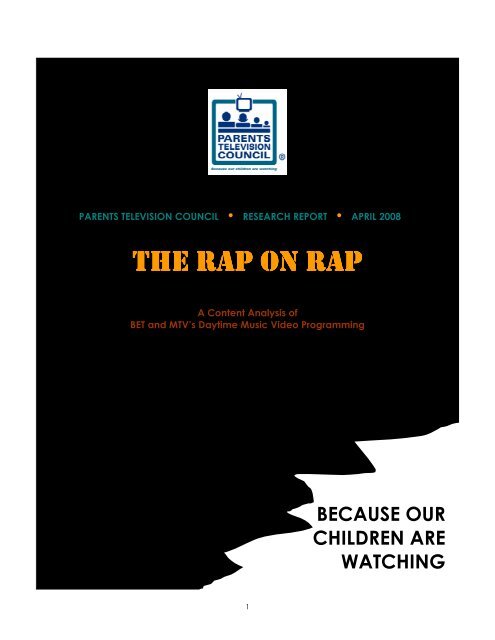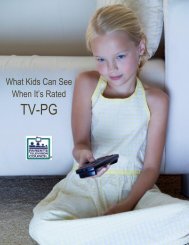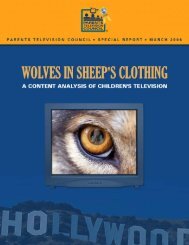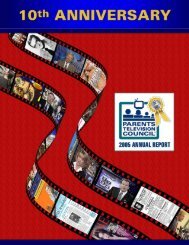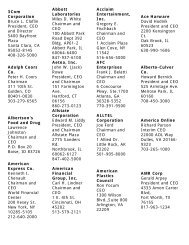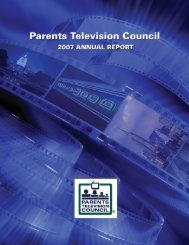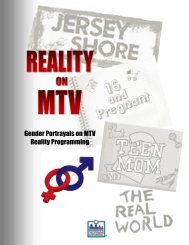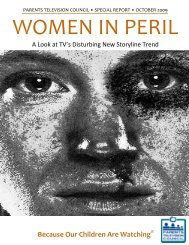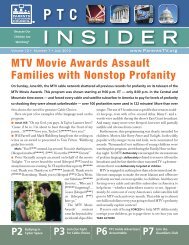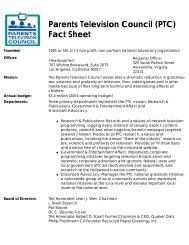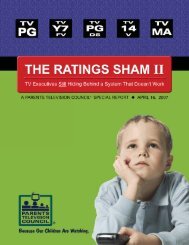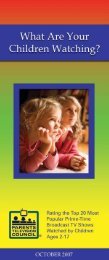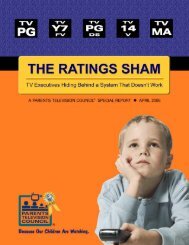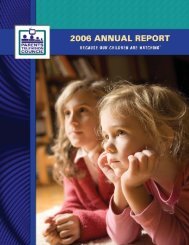THE RAP ON RAP THE RAP ON RAP - Parents Television Council
THE RAP ON RAP THE RAP ON RAP - Parents Television Council
THE RAP ON RAP THE RAP ON RAP - Parents Television Council
Create successful ePaper yourself
Turn your PDF publications into a flip-book with our unique Google optimized e-Paper software.
PARENTS TELEVISI<strong>ON</strong> COUNCIL • RESEARCH REPORT • APRIL 2008<br />
<strong>THE</strong> <strong>RAP</strong> <strong>ON</strong> <strong>RAP</strong><br />
A Content Analysis of<br />
BET and MTV’s Daytime Music Video Programming<br />
BECAUSE OUR<br />
CHILDREN ARE<br />
WATCHING<br />
1
TABLE OF C<strong>ON</strong>TENTS<br />
Executive Summary............................4<br />
Major Findings .......................................... 5<br />
Overall Content .............................5<br />
Content By Category.....................6<br />
Marketing Analyses.......................7<br />
Research Report..................................8<br />
Sampling .......................................8<br />
Methodology.................................8<br />
Content Analyses ..........................9<br />
Content By Category.....................9<br />
Marketing Analyses.....................15<br />
Conclusion...........................................20<br />
FOR MEDIA INQUIRIES<br />
PLEASE C<strong>ON</strong>TACT<br />
Kelly Oliver<br />
CRC Public Relations<br />
(703) 683-5004<br />
PARENTS TELEVISI<strong>ON</strong> COUNCIL<br />
LOS ANGELES HEADQUARTERS<br />
707 Wilshire Boulevard, Suite 2075<br />
Los Angeles, California 90017<br />
(213) 403-1300<br />
www.<strong>Parents</strong>TV.org<br />
The PTC is a 501(c)(3) nonprofit<br />
research and education foundation.<br />
© Copyright 2008 – <strong>Parents</strong> <strong>Television</strong> <strong>Council</strong><br />
2
<strong>THE</strong> <strong>RAP</strong> <strong>ON</strong> <strong>RAP</strong>: A Content Analysis of BET and MTV’s Daytime Music Video Programming • <strong>Parents</strong> <strong>Television</strong> <strong>Council</strong> • APRIL 10, 2008<br />
This study was conducted by the <strong>Parents</strong><br />
<strong>Television</strong> <strong>Council</strong> at the request of Reverend<br />
Delman Coates, Organizer of the “Enough Is<br />
Enough Campaign for Corporate<br />
Responsibility in Entertainment.” We wish to<br />
thank Reverend Coates and his organization<br />
for recommending this study, for providing<br />
guidance on the approach taken in this study,<br />
and for providing analytical assistance with<br />
terminologies that contributed meaningful<br />
insight into the colloquialisms contained in the<br />
programming under evaluation.<br />
The Enough Is Enough Campaign was<br />
organized to challenge the corporate<br />
sponsorship of lyrical and visual content that<br />
sexually objectifies women, promotes drug<br />
use, glorifies violence and criminal activity,<br />
and negatively stereotypes Black and Latino<br />
men as gangsters, pimps, and thugs. More<br />
information about the Enough Is Enough<br />
Campaign can be obtained at:<br />
www.enoughisenoughcampaign.com<br />
3
<strong>THE</strong> <strong>RAP</strong> <strong>ON</strong> <strong>RAP</strong><br />
A Content Analysis of<br />
BET and MTV’s Daytime Music Video Programming<br />
April 2008<br />
EXECUTIVE SUMMARY<br />
This report by the <strong>Parents</strong> <strong>Television</strong> <strong>Council</strong> (PTC) details an analysis of television<br />
content aired on daytime music video programming. The goal of this research was to<br />
assess the quality and degree of adult-themed music video content marketed to and<br />
viewed by children.<br />
Specifically, this report provides a detailed analysis of adult content that aired on<br />
BET’s Rap City and 106 & Park and on MTV’s Sucker Free on MTV. These shows were<br />
chosen due to their daily new and recent video releases as well as the fact that they all<br />
aired during afternoon or early evening hours. The PTC recorded every new episode of<br />
each program during a two-week period in December, 2007 (December 10-21), resulting<br />
in a sample of 25 episodes constituting a total of 27.5 hours of programming. Because<br />
the figures from this study period were strikingly high, the PTC conducted an additional<br />
week of analysis on the same three programs in March 2008 for purposes of validation.<br />
The data revealed even higher levels of adult content in March 2008 than in December<br />
2007.<br />
During these 27.5 hours in December and 14 hours in March, analysts noted every<br />
instance of explicit language, sex, violence, drugs (sales and/or use), and other illegal<br />
activity. Accompanying age-based ratings (e.g. TV-PG, TV-14) and content descriptors<br />
(S, D, L, V) were also examined for their utility in alerting parents to the presence of<br />
inappropriate content.<br />
In addition, this report details an analysis of the marketing of adult content to<br />
children on the aforementioned programs, noting the artists, songs, and albums<br />
promoted during the program, as well as record companies and other sponsors<br />
appearing in commercials. The PTC also analyzed Nielsen Media Research audience<br />
data for these programs to gain insight into the number of children who have become<br />
consumers of these media products.<br />
This study captures only a sample of the music video content on BET and MTV.<br />
Both networks air the same videos that appear in this study during other weekday<br />
timeslots, and during the weekend. For example, BET airs 106 & Park twice each<br />
weekday from 11:00 a.m. to12:30 p.m., and 6:00 p.m. to 7:30 p.m., and on Saturdays from<br />
11:00 a.m. to12:30 p.m. Rap City also airs each Saturday from 5:00 p.m. to 6:00 p.m. This<br />
study analyzes only the 6:00 p.m. weekday airing of 106 & Park, and the 5:00 p.m.<br />
weekday airing of Rap City. Therefore, the incidence of adult-themed content<br />
marketed to youth is actually higher on these networks, and their affiliated channels.<br />
4
<strong>THE</strong> <strong>RAP</strong> <strong>ON</strong> <strong>RAP</strong>: A Content Analysis of BET and MTV’s Daytime Music Video Programming • <strong>Parents</strong> <strong>Television</strong> <strong>Council</strong> • APRIL 10, 2008<br />
MAJOR FINDINGS<br />
OVERALL (explicit content across all categories: sex, language and violence)<br />
• There were 1342 instances of offensive/adult content in the 14 hours of<br />
programming analyzed during March, for an average of 95.8 instances per hour,<br />
1.6 instances per minute, or one instance of adult content every 38 seconds.<br />
• There were 1647 instances of offensive/adult content in the 27.5 hours of<br />
programming analyzed during the December study period, for an average of<br />
59.9 instances per hour, or nearly one instance every minute.<br />
• Relative to the December study period, sex constituted the majority of adult<br />
content in the analyzed videos (45%), followed by explicit language (29%),<br />
violence (13%), drugs use/sales (9%), and other illegal activity (3%). Although<br />
March data revealed higher quantities of content, the percentages reflected<br />
similar findings (42%, 37%, 10%, 9% and 2% respectively).<br />
• Out of the three shows examined in December, Rap City featured the highest<br />
levels of sex (31.6 instances per hour), explicit language (25.3 instances per hour),<br />
and violence (11.7 instances per hour); but MTV’s Sucker Free on MTV contained<br />
the highest levels of drug use/sales (10 instances per hour) and other illegal<br />
activity (2.4 instances per hour). Similar results were found in March.<br />
• To put this data in perspective, in the PTC’s most recent analysis of prime time<br />
broadcast TV Family Hour programming, the data revealed an average 12.5<br />
instances of violent, profane and sexual content per hour. This is equivalent to<br />
one instance every 4.8 minutes. Family Hour programming on broadcast TV<br />
contained an average of 4.5 instances of foul language, 3.8 instances of sexual<br />
content, and 4.2 instances of violent content per hour.<br />
• MTV can be credited with being slightly more responsible in assigning appropriate<br />
age-based ratings to its music video programs. All episodes of Sucker Free on<br />
MTV included in this analysis were rated TV-14. By contrast, almost every episode<br />
of 106 & Park and Rap City on BET carried only a TV-PG rating. Only one BET<br />
program was rated TV-14 and only one program on either network carried<br />
content descriptors. Therefore, these programs, as currently rated, would not<br />
work in conjunction with the V-Chip to block them from coming into the home or<br />
to warn parents about the presence of sexual content, suggestive dialogue,<br />
violence, or explicit language.<br />
5
<strong>THE</strong> <strong>RAP</strong> <strong>ON</strong> <strong>RAP</strong>: A Content Analysis of BET and MTV’s Daytime Music Video Programming • <strong>Parents</strong> <strong>Television</strong> <strong>Council</strong> • APRIL 10, 2008<br />
C<strong>ON</strong>TENT BY CATEGORY<br />
SEX<br />
• There were a total of 746 sexually explicit scenes or lyrical references in the 27.5<br />
hours of analyzed programming from the December study period for an average<br />
of 27 instances per hour, or one instance every 2.2 minutes.<br />
• Sexual content was even more common in the March study period, with an<br />
average 40 instances per hour, or one instance every 90 seconds.<br />
• 56% of the sexual content in the combined December and March videos fit into<br />
the broad category of “innuendo,” which are slang references for sex and sex<br />
acts.<br />
• Vulgar slang references to sexual anatomy (e.g. the term “gushy” used to refer to<br />
a woman’s lubricated vagina) increased from a mere 3 instances in December<br />
to 103 references in the one week March study period. Other categories of<br />
sexual content, such as direct/non-slang references to sex and depictions of<br />
strippers also increased dramatically.<br />
EXPLICIT LANGUAGE<br />
• There were 475 uses of explicit language and obscene gestures within the 27.5<br />
hours of programming examined in December, for an average of 17 instances<br />
per hour, or one instance every 3.5 minutes.<br />
• 91% of the expletives that aired during the December study period were muted<br />
or obscured, 9% were not. Non-muted/obscured expletives included the words<br />
“damn,” “bitch” “pissed,” as well as euphemisms for “fuck” and obscene<br />
gestures. Muted expletives included “dick,” “fuck,” “motherfucker,” “nigger,”<br />
“pussy,” “shit,” “ass,” “bitch,” “goddamn,” and “whore/ho.”<br />
• Explicit language increased substantially during the one week March study<br />
period, averaging 35 instances per hour, or one instance every 1.7 minutes.<br />
• While 83% of the expletives used during the March study period were muted, 17%<br />
were not. Non-muted expletives included the words “damn,” “hell,” “ass,” and<br />
“pissed,” as well as euphemisms for “fuck.” Muted expletives included “dick,”<br />
“fuck,” “motherfucker,” “nigger,” “pussy,” “shit,” “ass,” “bitch,” “goddamn,” and<br />
“whore/ho.”<br />
• The most commonly used expletive during both the December and March study<br />
period was (muted) “nigger,” which artists verbalized 148 times within a two week<br />
period in December and 136 times within the one week study period in March.<br />
(Muted) “fuck,” (muted) “bitch,” and (muted) “shit” followed with 78, 57 and 41<br />
verbalizations respectively for December, and 68, 60 and 52 respectively for<br />
March.<br />
• There were select instances when explicit language that aired in muted form<br />
during December 2007, aired in non-muted form in March 2008. The full meaning<br />
of these findings is unclear although this could indicate possible changes in<br />
network guidelines for labeling content “appropriate” versus “inappropriate.”<br />
6
<strong>THE</strong> <strong>RAP</strong> <strong>ON</strong> <strong>RAP</strong>: A Content Analysis of BET and MTV’s Daytime Music Video Programming • <strong>Parents</strong> <strong>Television</strong> <strong>Council</strong> • APRIL 10, 2008<br />
VIOLENCE<br />
• There were 221 violent depictions including deaths depicted or implied,<br />
explosions, implied violence, punching/hitting, rioting, threats and weapons in the<br />
December study period, for an average of 8 instances per hour, or one instance<br />
roughly every 7.5 minutes.<br />
• There were 134 violent depictions in the March study period, for an average of 9.6<br />
instances per hour, or one instance roughly every 6.3 minutes.<br />
• 55% of the violent content in the videos analyzed included the use or depiction of<br />
weapons, the second largest category of violence was deaths depicted or<br />
implied (16%), followed by threats of violence (11%).<br />
DRUGS AND O<strong>THE</strong>R ILLEGAL ACTIVITY<br />
• There were 205 depictions or discussions of drug sales or use and other illegal<br />
activity during the study period, for an average of 7.5 instances per hour, or<br />
roughly one instance every eight minutes.<br />
• The depiction of illegal narcotic use or sale dominated this category – 75% of<br />
references to or depictions of illegal activity in the analyzed videos were drugrelated.<br />
MARKETING ANALYSIS<br />
TV RATINGS<br />
• During the two week December 2007 study period, children under 18 made up<br />
approximately 40% of the viewing audience for 106 & Park, 41% of the audience<br />
for Rap City and 39% of the audience for Sucker Free on MTV. Because all of<br />
these programs re-air throughout the day, study results underestimate the<br />
percentage of unique children who are exposed or have been exposed to these<br />
programs in total.<br />
ADVERTISERS (Advertisers were only examined during the December study period)<br />
• The top advertiser across all 3 shows was Proctor & Gamble. Proctor & Gamble<br />
aired 78 ads within 27.5 hours of programming.<br />
• 41% of all commercials for the 3 shows were accounted for by 10 companies.<br />
They include: Proctor & Gamble, 20 th Century Fox, McDonalds Corporation,<br />
Universal Studios, YUM! Brands, General Motors Corporation, Vonage, Sony<br />
Computer Entertainment, Walt Disney Company, and AT&T Corporation.<br />
• 61% of the ads aired by the top 10 advertisers were aired on BET’s show 106 &<br />
Park.<br />
• Ads for albums were examined separately from other advertisers. Study results<br />
show that 86% of all album promotions were sponsored by 2 labels: Universal<br />
Music (55%) and Warner Music (31%).<br />
7
<strong>THE</strong> <strong>RAP</strong> <strong>ON</strong> <strong>RAP</strong>: A Content Analysis of BET and MTV’s Daytime Music Video Programming • <strong>Parents</strong> <strong>Television</strong> <strong>Council</strong> • APRIL 10, 2008<br />
<strong>THE</strong> <strong>RAP</strong> <strong>ON</strong> <strong>RAP</strong><br />
A Content Analysis of<br />
BET and MTV’s Daytime Music Video Programming<br />
April 2008<br />
RESEARCH REPORT<br />
This report by the PTC details an analysis of television content aired on daytime music<br />
video programming. The goal of this project was to assess the quality and degree of<br />
adult-themed music video content marketed to and viewed by children.<br />
SAMPLING<br />
During a two-week period from December 10, 2007 to December 21, 2007, the<br />
<strong>Parents</strong> <strong>Television</strong> <strong>Council</strong> recorded every new episode of Rap City (BET), 106 & Park (BET)<br />
and Sucker Free on MTV (MTV), resulting in a sample of 25 episodes containing a total of<br />
27.5 hours of programming. These shows were chosen due to their daily new and recent<br />
video releases. For purposes of validation, the same three shows were then recorded<br />
and analyzed for a one week period from March 7, 2008 to March 13, 2008 for a total of<br />
14 hours of programming.<br />
METHODOLOGY<br />
Each episode was viewed by a trained analyst who conducted a detailed<br />
analysis of both visual and verbal content. Programs were analyzed in their entirety. This<br />
included the presentation of music videos, as well as all other program content such as<br />
host-guest interviews.<br />
Every instance of offensive language, drug sales or use, violence, illegal activity<br />
and sexual content was logged. For all categories of offensive content the analysis was<br />
determined by what aired in the video. This is significant given many instances in which<br />
a song’s lyrics are changed from what is heard on the album to what is heard on the<br />
music video. In the event of a muted profanity or reference, the word was verified either<br />
by reviewing lyrics from a third-party webpage or listening to an uncensored version of a<br />
song.<br />
Language was coded for specific words uttered within programming and certain<br />
related euphemisms – such as the word “screw” when used as a euphemism for “fuck.”<br />
Also coded were cases of bleeped and otherwise obscured language. This included<br />
words that were partially obscured but identifiable, as well as obscene gestures. All<br />
incidents of verbal and visual sexual material were coded, including anatomical<br />
references in a sexual context, strippers, suggestive dancing, and sexual innuendo.<br />
Violent content included person-on-person violence, violent threats, implications of<br />
death, self-inflicted violence, all references to weapons and general mayhem.<br />
Although the three shows were selected for their similarity in content, there are<br />
variations in program format. Rap City airs music videos in their entirety, and also<br />
features interview segments with guest artists, who are often promoting albums. Freestyle<br />
8
<strong>THE</strong> <strong>RAP</strong> <strong>ON</strong> <strong>RAP</strong>: A Content Analysis of BET and MTV’s Daytime Music Video Programming • <strong>Parents</strong> <strong>Television</strong> <strong>Council</strong> • APRIL 10, 2008<br />
performances by guests may also be shown during an episode. The show airs Monday<br />
through Friday at 5:00 p.m. Eastern Time and each episode lasts one hour. 106 & Park is a<br />
video countdown show with a live audience. Videos in the countdown are usually not<br />
shown in their entirety. The show airs Monday through Friday at 6:00 p.m. Eastern Time<br />
and each episode lasts 1.5 hours. Sucker Free on MTV is presented in an interviewcentered<br />
format, with the guests generally promoting an album. Very short segments of<br />
music videos are shown. The program lasts one half hour and airs Tuesday through<br />
Thursday at 8:00 a.m. Eastern Time. Several episodes did not air as scheduled during our<br />
December study period. One recording of Sucker Free from our sample failed due to<br />
technical difficulties, reducing the hours examined in December from 28 to 27.5 hours.<br />
RESULTS<br />
OVERALL (Explicit content across all categories including sex, language and violence)<br />
During the 14 hours of March programming, there were a total of 1342 instances<br />
of explicit adult content aired within the timeframe of 1 week. This included language<br />
(n= 495), sex (n = 560), violence (n = 134), drugs (n = 120) and other illegal activity (n = 33)<br />
(see Table #1 below). Not a single episode of any of the three programs was free of<br />
such content. These numbers are equivalent to an average of 95.8 instances per hour,<br />
1.6 instances per minute, or one instance of adult content every 38 seconds.<br />
As seen in tables #2 thru #5, comparisons between the three shows identify Rap<br />
City as featuring the highest levels of explicit adult content across all categories: sex,<br />
explicit language, violence, drugs and other illegal activity.<br />
There were 1647 instances of offensive/adult content in the 27.5 hours of<br />
programming analyzed during the December study period, for an average of 59.9<br />
instances per hour, or nearly one instance every minute. Sex constituted the majority of<br />
adult content in the analyzed videos (45%), followed by explicit language (29%),<br />
violence (13%), drugs use/sales (9%), and other illegal activity (3%). Although March data<br />
revealed higher quantities of content, the percentages reflected similar findings.<br />
Out of the three shows examined in December, Rap City featured the highest<br />
levels of sex (31.6 instances per hour), explicit language (25.3 instances per hour), and<br />
violence (11.7 instances per hour); but MTV’s Sucker Free on MTV contained the highest<br />
levels of drug use/sales (10 instances per hour) and other illegal activity (2.4 instances per<br />
hour). Similar results were found in March.<br />
To put this data in perspective, in the PTC’s most recent analysis of prime time<br />
broadcast TV Family Hour programming, the data revealed an average 12.5 instances of<br />
violent, profane and sexual content per hour. This is equivalent to one instance every 4.8<br />
minutes. Family Hour programming on broadcast TV contained an average of 4.5<br />
instances of foul language, 3.8 instances of sexual content, and 4.2 instances of violent<br />
content per hour.<br />
Table #1: Explicit/Adult Content Across Content Areas<br />
Language Sex Violence Drugs<br />
Illegal<br />
Activity<br />
TOTAL<br />
C<strong>ON</strong>TENT<br />
December 2007 475 746 221 154 51 1647<br />
March 2008 495 560 134 120 33 1342<br />
9
<strong>THE</strong> <strong>RAP</strong> <strong>ON</strong> <strong>RAP</strong>: A Content Analysis of BET and MTV’s Daytime Music Video Programming • <strong>Parents</strong> <strong>Television</strong> <strong>Council</strong> • APRIL 10, 2008<br />
C<strong>ON</strong>TENT BY CATEGORY<br />
Sex<br />
As table #2 shows, there was a total of 746 sexually explicit scenes or lyrical<br />
references in the 27.5 hours of analyzed programming from the December study period<br />
for an average of 27 instances per hour, or one instance every 2.2 minutes. There were a<br />
total of 560 sexually explicit scenes or lyrical references in the 14 hours of analyzed<br />
programming from the March study period, for an average of 40 instances per hour, or<br />
one instance every 90 seconds.<br />
Eight forms of sexual content were identified in the program for both study<br />
periods: anatomical references (the use of slang words to identify body parts associated<br />
with sexual functions); clothing (sexually provocative outerwear); condoms;<br />
pornography; sexual innuendo (slang references used to communicate sex or sex acts);<br />
sexual references (non-slang/direct utterances of the word “sex”); strippers; and<br />
suggestive dancing.<br />
The highest percentage of sexual content in the combined December and<br />
March videos fit into the broad category of non-specific “innuendo” (56%). However,<br />
Rap City aired more sexually explicit content overall in contrast to 106 & Park. 106 & Park<br />
aired more provocative clothing, sexual innuendo, and depiction of strippers. In<br />
addition, the data revealed increases in vulgar slang references to sexual anatomy (e.g.<br />
the term “gushy” used to refer to a woman’s lubricated vagina) from a mere 3 instances<br />
in December to 103 references in the one week March study period. Other categories<br />
of sexual content, such as direct/non-slang references to sex and depictions of strippers<br />
also increased dramatically. It is also important to note that, relative to pornography, no<br />
actual pornographic scenes were aired.<br />
Table #2: Sexual Content By Show for March 2008 and December 2007<br />
Rap<br />
City<br />
(BET)<br />
March<br />
2008<br />
106 &<br />
Park<br />
(BET)<br />
March<br />
2008<br />
Sucker<br />
Free<br />
(MTV)<br />
March<br />
2008<br />
TOTAL<br />
March<br />
2008<br />
SEX<br />
Anatomical Reference 99 3 1 103<br />
Clothing 26 43 13 82<br />
Condoms 2 2 1 5<br />
Pornography 2 -- -- 2<br />
Sexual Innuendo 107 137 39 283<br />
Sexual Reference 8 -- -- 8<br />
Strippers 4 21 4 29<br />
Suggestive Dancing 19 19 10 48<br />
TOTAL 267 225 68 560<br />
10
<strong>THE</strong> <strong>RAP</strong> <strong>ON</strong> <strong>RAP</strong>: A Content Analysis of BET and MTV’s Daytime Music Video Programming • <strong>Parents</strong> <strong>Television</strong> <strong>Council</strong> • APRIL 10, 2008<br />
Table #2 (cont’d): Sexual Content By Show for March 2008 and December 2007<br />
Rap<br />
City<br />
(BET)<br />
Dec.<br />
2007<br />
106 &<br />
Park<br />
(BET)<br />
Dec.<br />
2007<br />
Sucker<br />
Free<br />
(MTV)<br />
Dec.<br />
2007<br />
TOTAL<br />
Dec.<br />
2007<br />
SEX<br />
Anatomical Reference 3 4 1 8<br />
Clothing 64 82 20 166<br />
Condoms 18 -- -- 18<br />
Pornography 1 2 -- 3<br />
Sexual Innuendo 171 234 43 448<br />
Sexual Reference 3 1 -- 4<br />
Strippers 2 7 2 11<br />
Suggestive Dancing 54 27 7 88<br />
TOTAL 316 357 73 746<br />
Language<br />
Table #3 reveals 495 uses of explicit language and obscene gestures in the<br />
March study period, for an average of 35 instances per hour, or one instance every 1.7<br />
minutes. While language aired in both muted and non-muted form, obscene gestures<br />
were obscured. All of the obscene gestures noted by the analysts were individuals/artists<br />
presenting extended middle fingers as a symbol of the word “fuck” or concept “fuck<br />
you.” There were 475 uses of explicit language and obscene gestures within the 27.5<br />
hours of programming examined in December, for an average of 17 instances per hour,<br />
or one instance every 3.5 minutes. While 91% of the expletives used during the<br />
December study period were muted or obscured, 9% were not. Non-muted/obscured<br />
expletives included the words “damn,” “bitch” “pissed,” as well as euphemisms for “fuck”<br />
and obscene gestures. Muted expletives included “dick,” “fuck,” “motherfucker,”<br />
“nigger,” “pussy,” “shit,” “ass,” “bitch,” “goddamn,” and “whore/ho.”<br />
Eighty three percent of the expletives used in the March study period were<br />
muted, 17% were not. Non-muted expletives included the words “damn,” “hell,” “ass,”<br />
and “pissed,” as well as euphemisms for “fuck.” Muted expletives included “dick,”<br />
“fuck,” “motherfucker,” “nigger,” “pussy,” “shit,” “ass,” “bitch,” “goddamn,” and<br />
“whore/ho.”<br />
The most commonly used expletive during the December and March study<br />
period was (muted) “nigger” (n = 148 and 136 respectively). Aside from the use of the<br />
word “nigger,” the words “fuck,” “bitch,” and “shit” appear to be the next most<br />
frequently used words within the observed programming. The words “ho” and “whore”<br />
were also used but later combined into one category. Analysts noted that “ho” was<br />
used significantly more frequently than the word “whore.” However, both words were<br />
always presented in muted form.<br />
Interestingly, there were instances when explicit language that aired in muted<br />
form during December 2007, did not air in muted form in March 2008. The full meaning of<br />
these findings is unclear although this could indicate possible changes in network<br />
guidelines for labeling content “appropriate” versus “inappropriate.”<br />
11
<strong>THE</strong> <strong>RAP</strong> <strong>ON</strong> <strong>RAP</strong>: A Content Analysis of BET and MTV’s Daytime Music Video Programming • <strong>Parents</strong> <strong>Television</strong> <strong>Council</strong> • APRIL 10, 2008<br />
Table #3: Explicit/Adult Language By Show For March 2008 and December 2007<br />
Rap<br />
City<br />
(BET)<br />
March<br />
2008<br />
106 &<br />
Park<br />
(BET)<br />
March<br />
2008<br />
Sucker<br />
Free<br />
(MTV)<br />
March<br />
2008<br />
TOTAL<br />
March<br />
2008<br />
MUTED<br />
EXPLETIVES<br />
Ass 19 9 2 30<br />
Bitch 32 22 6 60<br />
Dick 13 4 -- 17<br />
Fuck 46 19 3 68<br />
God audible damn 3 -- -- 3<br />
Goddamn 6 7 2 15<br />
Ho 6 3 2 11<br />
Motherfucker 4 -- 2 6<br />
Nigger 95 34 7 136<br />
Pussy 6 1 1 8<br />
Shit 30 15 7 52<br />
Whore 1 3 -- 4<br />
N<strong>ON</strong>-MUTED<br />
EXPLETIVES<br />
Ass -- 6 1 7<br />
Damn 4 12 2 18<br />
Fuck Euphemism 10 5 3 18<br />
Hell 19 15 1 35<br />
Obscene gesture Obscured 4 1 -- 5<br />
Pissed 2 -- -- 2<br />
TOTAL 300 156 39 495<br />
12
<strong>THE</strong> <strong>RAP</strong> <strong>ON</strong> <strong>RAP</strong>: A Content Analysis of BET and MTV’s Daytime Music Video Programming • <strong>Parents</strong> <strong>Television</strong> <strong>Council</strong> • APRIL 10, 2008<br />
Table #3 Cont’d: Explicit/Adult Language By Show For March 2008 and December 2007<br />
Rap<br />
City<br />
(BET)<br />
Dec.<br />
2007<br />
106 &<br />
Park<br />
(BET)<br />
Dec.<br />
2007<br />
Sucker<br />
Free<br />
(MTV)<br />
Dec.<br />
2007<br />
TOTAL<br />
Dec.<br />
2007<br />
MUTED<br />
EXPLETIVES<br />
Ass 18 7 2 27<br />
Bitch 18 57 3 78<br />
Damn 4 1 -- 5<br />
Dick 10 2 1 13<br />
Fuck 7 33 1 41<br />
God audible damn 5 -- 1 6<br />
Goddamn 12 3 -- 15<br />
Ho 12 1 1 14<br />
Motherfucker 9 2 2 13<br />
Nigger 90 43 15 148<br />
Pussy 3 1 -- 4<br />
Shit 23 32 2 57<br />
Whore 4 -- 2 6<br />
N<strong>ON</strong>-MUTED<br />
EXPLETIVES<br />
Bitch 5 -- -- 5<br />
Damn 21 -- 2 23<br />
Fuck Euphemism -- 2 -- 2<br />
Obscene gesture 2 -- 1 3<br />
Obscene gesture Obscured 4 3 -- 7<br />
Pissed 6 -- 2 8<br />
TOTAL 253 187 35 475<br />
Violence<br />
As seen in Table #4, categories of violence included: death implied, explosions,<br />
implied violence, punching, rioting, threats, and weapons. Collectively, there were a<br />
total of 221 violent depictions in the December study period for an average of 8<br />
instances per hour, or one instance roughly every 7.5 minutes. March data revealed a<br />
total of 134 violent depictions for an average of 9.6 instances per hour, or one instance<br />
roughly every 6.3 minutes. The study also showed that 55% of the violent content in the<br />
videos analyzed included the reference or depiction of weapons.<br />
13
<strong>THE</strong> <strong>RAP</strong> <strong>ON</strong> <strong>RAP</strong>: A Content Analysis of BET and MTV’s Daytime Music Video Programming • <strong>Parents</strong> <strong>Television</strong> <strong>Council</strong> • APRIL 10, 2008<br />
Table #4: Violent Content By Show For March 2008 and December 2007<br />
Rap<br />
City<br />
(BET)<br />
March<br />
2008<br />
106 &<br />
Park<br />
(BET)<br />
March<br />
2008<br />
Sucker<br />
Free<br />
(MTV)<br />
March<br />
2008<br />
TOTAL<br />
March<br />
2008<br />
VIOLENCE<br />
Death Implied 5 2 -- 7<br />
Explosion 3 -- -- 3<br />
Implied Violence 24 9 1 34<br />
Punch 6 -- -- 6<br />
Riot -- 1 -- 1<br />
Threat 12 2 -- 14<br />
Weapons 52 12 5 69<br />
TOTAL 102 26 6 134<br />
Rap<br />
City<br />
(BET)<br />
Dec.<br />
2007<br />
106 &<br />
Park<br />
(BET)<br />
Dec.<br />
2007<br />
Sucker<br />
Free<br />
(MTV)<br />
Dec.<br />
2007<br />
TOTAL<br />
Dec.<br />
2007<br />
VIOLENCE<br />
Blood -- 2 -- 2<br />
Death Implied 20 15 1 36<br />
Explosion 4 1 -- 5<br />
Implied Violence 12 7 1 20<br />
Punch 9 -- -- 9<br />
Shove 3 -- -- 3<br />
Threat 8 12 4 24<br />
Weapons 61 54 7 122<br />
TOTAL 117 91 13 221<br />
Drugs and Other Illegal Activity<br />
A significant percentage of the illegal activity referenced or depicted within the<br />
programming focused on the sale or use of drugs (75% in December and 78% in March)<br />
for a total of 154 and 120 instances respectively. This is equivalent to an average of 8.6<br />
instances per hour, or roughly one instance every seven minutes during March and an<br />
average of 5.6 instances per hour, or roughly one instance every 10.7 minutes in<br />
December. Other illegal activity included money laundering, street gambling and<br />
references to underage drinking.<br />
14
<strong>THE</strong> <strong>RAP</strong> <strong>ON</strong> <strong>RAP</strong>: A Content Analysis of BET and MTV’s Daytime Music Video Programming • <strong>Parents</strong> <strong>Television</strong> <strong>Council</strong> • APRIL 10, 2008<br />
Table #5: A Comparison of Drugs and Other Illegal Activity By Show<br />
For March 2008 and December 2008<br />
Rap<br />
City<br />
(BET)<br />
March<br />
2008<br />
106 &<br />
Park<br />
(BET)<br />
March<br />
2008<br />
Sucker<br />
Free<br />
(MTV)<br />
March<br />
2008<br />
TOTAL<br />
March<br />
2008<br />
DRUGS & O<strong>THE</strong>R<br />
ILLEGAL ACTIVITY<br />
Drugs 81 32 7 120<br />
Other Ill. Activity 21 9 3 33<br />
TOTAL 102 41 10 153<br />
Rap<br />
City<br />
(BET)<br />
Dec.<br />
2007<br />
106 &<br />
Park<br />
(BET)<br />
Dec.<br />
2007<br />
Sucker<br />
Free<br />
(MTV)<br />
Dec.<br />
2007<br />
TOTAL<br />
Dec.<br />
2007<br />
DRUGS & O<strong>THE</strong>R<br />
ILLEGAL ACTIVITY<br />
Drugs 84 45 25 154<br />
Other Ill. Activity 20 25 6 51<br />
TOTAL 104 70 31 205<br />
TV Ratings<br />
<strong>Parents</strong> who seek to protect their children from inappropriate content sometimes<br />
look to TV ratings for guidance. These ratings are assigned by the television networks to<br />
their own programming. MTV can be credited with being slightly more responsible in<br />
assigning appropriate age-based ratings to its music video programs. All episodes of<br />
Sucker Free on MTV included in this analysis were rated TV-14. By contrast, almost every<br />
episode of 106 & Park and Rap City on BET carried only a TV-PG rating. An exception<br />
was found with one show that aired in December, was rated TV-14 and included<br />
descriptors for suggestive dialogue (D), foul language (L), and sex (S). Excluding this one<br />
program, neither network carried content descriptors that would work in conjunction with<br />
the V-Chip to block the programs from coming into the home or to warn parents about<br />
the presence of sexual content, suggestive dialogue, violence, or foul language.<br />
MARKETING ANALYSIS<br />
Audience Data and TV Ratings<br />
For 106 & Park, the audience for the episodes in our study averaged<br />
approximately 94,000 viewers ages 2-to-11, and approximately 164,000 viewers ages 12-<br />
to-17, out of a total audience (age 2+) of approximately 643,000. Thus, children under 18<br />
made up approximately 40% of the viewing audience. The show also re-airs during other<br />
time slots, so these numbers underestimate the total audience that sees each episode.<br />
The audience for Rap City averaged approximately 58,000 2-to-11-year-olds and 89,000<br />
12-to-17-year-olds for the episodes we analyzed. Thus, children make up approximately<br />
41% of the total audience (age 2+) of approximately 362,000. The average audience<br />
15
<strong>THE</strong> <strong>RAP</strong> <strong>ON</strong> <strong>RAP</strong>: A Content Analysis of BET and MTV’s Daytime Music Video Programming • <strong>Parents</strong> <strong>Television</strong> <strong>Council</strong> • APRIL 10, 2008<br />
(age 2+) for Sucker Free on MTV during our study period was 220,000, including about<br />
18,000 younger and 67,000 older children. Children thus represented approximately 39%<br />
of the viewing audience. (Data are from the Nielsen Media Research.)<br />
ADVERTISERS<br />
The March study period primarily focused on program content and did not<br />
include an examination of advertisers. There were a total of 911 commercial<br />
advertisements represented by 87 companies. Most were national advertisers including<br />
major department stores, telecommunications companies, film studios, major food<br />
chains, car manufacturers, and many more. The top advertiser across all three shows<br />
during the December study period was Proctor & Gamble. P&G aired 78 ads within 27.5<br />
hours of programming. 41% of all commercials for the three shows were accounted for<br />
by 10 companies. They included: Proctor & Gamble, 20 th Century Fox, McDonalds<br />
Corporation, Universal Studios, Yum! Brands, General Motors Corporation, Vonage, Sony<br />
Computer Entertainment, Walt Disney Company, and AT&T Corporation. 61% of the ads<br />
aired by the top 10 advertisers were aired on BET’s show 106 & Park.<br />
Ads for albums were examined separately from other advertisers. Study results<br />
show that 86% of all album promotions were sponsored by 2 labels: Universal Music (55%)<br />
and Warner Music (31%).<br />
Table #6: Top 10 Advertisers Across all Programming<br />
Company<br />
Rap City<br />
# of<br />
Commercials<br />
106 & Park<br />
# of<br />
Commercials<br />
Sucker Free<br />
# of<br />
Commercials<br />
TOTAL<br />
COMMERCIALS<br />
Procter & Gamble Co. 17 54 7 78<br />
20 th Century Fox 19 26 1 46<br />
McDonalds Corp. 20 23 0 43<br />
Universal Studios 14 30 7 41<br />
YUM! Brands 11 25 0 36<br />
General Motors Corp. 18 11 0 29<br />
Vonage 8 20 0 28<br />
Sony Computer Ent. 10 13 4 27<br />
Walt Disney Co. 9 13 1 23<br />
AT&T Corp. 10 11 0 21<br />
In a separate analysis, PTC examined advertisements that were sponsored by<br />
record labels. Study results show a total of 6 record labels were responsible for the 137<br />
advertisements that aired during programming (see Table #7).<br />
16
<strong>THE</strong> <strong>RAP</strong> <strong>ON</strong> <strong>RAP</strong>: A Content Analysis of BET and MTV’s Daytime Music Video Programming • <strong>Parents</strong> <strong>Television</strong> <strong>Council</strong> • APRIL 10, 2008<br />
Table #7: Record Labels As Advertisers<br />
Ads<br />
Shown on<br />
Rap City<br />
Ads<br />
Shown on<br />
106 &<br />
Park<br />
Ads<br />
Shown on<br />
Sucker<br />
Free MTV<br />
TOTAL<br />
ADS<br />
ADS W/PA<br />
WARNINGS<br />
ADS<br />
W/OUT PA<br />
WARNINGS<br />
Warner Music 27 49 5 81 37 44<br />
Universal Music 24 118 0 142 83 59<br />
Sony BMG 0 23 0 23 1 22<br />
EMI 0 2 0 2 0 2<br />
Babygrande 2 5 0 7 0 7<br />
TVT 1 2 0 3 0 3<br />
TOTAL 54 199 5 258 121 137<br />
Play Selections<br />
Table # 8 lists the song titles and artists for the videos selected for play on the<br />
programs airing in December 2007. They represent a two-week sample and are ordered<br />
from the most-played to the least-played videos. A total of 54 unique titles were<br />
represented, with 33 videos played in full at least once, and 21 additional videos from<br />
which only excerpts were shown. Accounting for repeat plays, a total of 87 full-length<br />
videos and 124 video excerpts were shown during the 27.5 hours of programming<br />
analyzed. Because of repeated plays, the 12 most-played video titles made up twothirds<br />
(58 of 87) of all full length video airings.<br />
Table #8: Videos Selected for Play Between<br />
December 10, 2007 and December 21, 2007<br />
Play Volume<br />
Song Title<br />
Artist<br />
Fulllength<br />
Excerpted<br />
Superstar Lupe Fiasco 7 1<br />
Playas Rock Hurricane Chris feat. Boxie 6 1<br />
100 Million Birdman feat. Rick Ross, Young<br />
5 2<br />
Jeezy, Lil Wayne, DJ Khaled & Cool<br />
& Dre<br />
Speedin' Rick Ross feat. R. Kelly 5 1<br />
Blow Your Mind Styles P feat. Swizz Beatz 5<br />
Independent Webbie feat. Lil Phat & Lil Boosie 5<br />
Turnin Headz Mike Jones 5<br />
Sweetest Girl (Dollar Bill) Remix Wyclef feat. Akon, Lil Wayne,<br />
Raekwon & Niia<br />
4 1<br />
Get It Big Trap Starz Click 4<br />
Girl You Know Scarface feat. Trey Songz 4<br />
Hit The Dance Floor UNK feat. Baby D 4<br />
Red Monkey Jeans Johnte 4<br />
Still Will 50 Cent feat. Akon 3<br />
Fly Like Me Chingy feat. Amerie 2 7<br />
17
<strong>THE</strong> <strong>RAP</strong> <strong>ON</strong> <strong>RAP</strong>: A Content Analysis of BET and MTV’s Daytime Music Video Programming • <strong>Parents</strong> <strong>Television</strong> <strong>Council</strong> • APRIL 10, 2008<br />
I'm So Hood (The Remix)<br />
DJ Khaled feat. Young Jeezy,<br />
Ludacris, Busta Rhymes, Big Boi, Lil<br />
Wayne, Fat Joe, Birdman, Rick Ross<br />
2 2<br />
All The Above Beanie Sigel feat. R. Kelly 2 1<br />
I Won't Tell Fat Joe 2 1<br />
Christmas in Hollis Run-DMC 2<br />
Dey Know Shawty Lo 2<br />
Just Fine Mary J. Blige 1 11<br />
Suffocate J. Holliday 1 10<br />
Crying Out For Me Mario 1 8<br />
Girlfriend Bow Wow & Omarion 1 3<br />
Givin Me A Rush Tyra B 1 3<br />
Low Flo Rida feat. T-Pain 1 3<br />
Be OK Chrisette Michele 1 1<br />
Heard 'Em Say Kanye West feat. Adam Levine 1<br />
I Remember Keyshia Cole 1<br />
Killa Cherish feat. Yung Joc 1<br />
Love Him Like I Do<br />
Dietrich Hadden feat. Ruben<br />
Studdard & Mary Mary<br />
1<br />
Santa Claus Goes Straight To<br />
The Ghetto<br />
Snoop Dogg feat. Daz, Bad Azz &<br />
Nate Dogg<br />
Secret Admirer Pitbull feat. Lloyd 1<br />
Wow Kia Shine 1<br />
With You Chris Brown 11<br />
Like You'll Never See Me Again Alicia Keys 10<br />
Pop Bottles Birdman feat. Lil Wayne & Jadakiss 9<br />
Roc Boys (And The Winner Is) Jay-Z 9<br />
Take You There Sean Kingston 7<br />
Falsetto The Dream 4<br />
Can't Help But Wait Trey Songz 3<br />
Sensual Seduction Snoop Dogg 2<br />
All I Need Method Man & Mary J. Blige 1<br />
Down In The Dirty Ludacris feat. Bun B & Rick Ross 1<br />
Freaky Gurl Gucci Mane 1<br />
G-Slide Lil Mama 1<br />
Hate That I Love You Rihanna feat. Ne-Yo 1<br />
I Know What You Want<br />
Busta Rhymes & Mariah Carey feat.<br />
Flipmode Squad<br />
1<br />
I Want You Common 1<br />
Me, Myself & I Beyonce 1<br />
1<br />
Real Love Mary J. Blige 1<br />
Shoulda Let You Go Keyshia Cole Introducing Amina 1<br />
Soulja Girl Soulja Boy Tell 'Em 1<br />
Sweetest Girl (Dollar Bill) Wyclef feat. Akon, Lil Wayne & Niia 1<br />
Wait A Minute (Just A Touch) Estelle 1<br />
18
<strong>THE</strong> <strong>RAP</strong> <strong>ON</strong> <strong>RAP</strong>: A Content Analysis of BET and MTV’s Daytime Music Video Programming • <strong>Parents</strong> <strong>Television</strong> <strong>Council</strong> • APRIL 10, 2008<br />
Albums Promoted<br />
A total of 48 in-show promotions of music albums occurred during the 27.5 hours<br />
of programming, and there were 228 commercial advertisements for music albums<br />
during the programming breaks for these episodes. Of the 228 commercial<br />
advertisements, 106 (46%) were for albums that received a Parental Advisory. Of the 48<br />
in-show promotions, 19 (40%) were for albums that received a Parental Advisory (see<br />
Table #9). Promotions were not examined in the comparative March sample.<br />
Table #9: Albums Promoted in Commercials Between<br />
December 10, 2007 and December 21, 2007<br />
Album Title<br />
Artist<br />
PA<br />
rating Commercials<br />
The Cool Lupe Fiasco No 32<br />
Back to the Trap House Gucci Mane Yes 27<br />
Growing Pains Mary J Blige No 26<br />
Hate It or Love It Chingy Yes 21<br />
5 Star Stunna Birdman Yes 15<br />
The Solution Beanie Sigel Yes 13<br />
American Gangster Jay-Z Yes 12<br />
Best of 2Pac 2Pac Yes 11<br />
Love Hate The Dream No 10<br />
Graduation Kanye West No 10<br />
Face Off<br />
Bow Wow &<br />
Omarion No 9<br />
Makings of a Man Jaheim No 8<br />
Hi-Teknology3 Hi-Tek No 6<br />
Made Scarface Yes 6<br />
Go Mario No 4<br />
Carnival Vol. II Wyclef Jean No 4<br />
Crunk Hits Vol. 4 Various Artists No 3<br />
8 Diagrams Wu-Tang Clan No 3<br />
Now 26 Various Artists No 2<br />
Baby Makin' Project Jagged Edge No 2<br />
Motown Boyz II Men No 2<br />
Get Off the Stage Too Short Yes 1<br />
This Christmas Soundtrack No 1<br />
Table #10: Albums Promoted In-Show Between<br />
December 10, 2007 and December 21, 2007<br />
Album Title<br />
Artist<br />
PA<br />
rating In-show Promotions<br />
The Solution Beanie Sigel Yes 7<br />
5 Star Stunna Birdman * 7<br />
Growing Pains Mary J Blige No 7<br />
The Cool Lupe Fiasco No 6<br />
Back to the Trap House Gucci Mane Yes 5<br />
Hate It or Love It Chingy * 5<br />
10 Years of Bling Vol. 1 Various Artists * 2<br />
19
<strong>THE</strong> <strong>RAP</strong> <strong>ON</strong> <strong>RAP</strong>: A Content Analysis of BET and MTV’s Daytime Music Video Programming • <strong>Parents</strong> <strong>Television</strong> <strong>Council</strong> • APRIL 10, 2008<br />
Fight of My Life Kirk Franklin No 2<br />
Mr. Untouchable Soundtrack No 1<br />
Go Mario No 1<br />
Face Off<br />
Bow Wow &<br />
Omarion No 1<br />
Love Hate The Dream * 1<br />
8 Diagrams Wu-Tang Clan * 1<br />
Super Gangster, Extraordinary<br />
Gentleman Styles P No 1<br />
We the Best DJ Khaled Yes 1<br />
Hi-Teknology3 Hi-Tek No 0<br />
Best of 2Pac 2Pac Yes 0<br />
Made Scarface Yes 0<br />
Get Off the Stage Too Short Yes 0<br />
Crunk Hits Vol. 4 Various Artists No 0<br />
Now 26 Various Artists No 0<br />
This Christmas Soundtrack No 0<br />
American Gangster Jay-Z Yes 0<br />
Graduation Kanye West No 0<br />
Makings of a Man Jaheim No 0<br />
Carnival Vol. II Wyclef Jean No 0<br />
Baby Makin' Project Jagged Edge No 0<br />
Motown Boyz II Men No 0<br />
*Parental Advisory was included on some, but not all, of the promotions.<br />
C<strong>ON</strong>CLUSI<strong>ON</strong><br />
Based upon study findings and audience averages from Nielsen Media Research,<br />
the PTC concludes that explicit adult content is reaching large numbers of youth and<br />
children ages 2-to-18-years-of-age through music video programming. This study<br />
revealed the highest numbers of explicit content seen in the history of PTC media<br />
research. Particularly, when considering that the above-stated numbers represent an<br />
underestimation due to our exclusion of re-aired programming.<br />
Comparisons between the amount of explicit content observed during analyses<br />
of prime time broadcast TV family hour programming and the amount of content in the<br />
current study sample of music video programming represents an extreme contrast. 1342<br />
instances of offensive/adult content in 14 hours of programming is a challenging quantity<br />
for the average adult. What impact must this content have on the minds of children who<br />
are watching the equivalent of 95.8 instances of sex, explicit language, violence, drugs<br />
and other illegal activity per hour of viewing? In other words, 1 instance of adult content<br />
every 38 seconds?<br />
In a letter written to Reverend Delman Coates from Debra Lee, CEO of Black<br />
Entertainment <strong>Television</strong> (BET), the following was stated regarding network programming<br />
guidelines:<br />
• BET does not air programming that endorses or condones illegal drugs or<br />
gratuitous violence;<br />
• BET has a list of words that are forbidden on our channel;<br />
20
<strong>THE</strong> <strong>RAP</strong> <strong>ON</strong> <strong>RAP</strong>: A Content Analysis of BET and MTV’s Daytime Music Video Programming • <strong>Parents</strong> <strong>Television</strong> <strong>Council</strong> • APRIL 10, 2008<br />
• BET does not air music videos that contain graphic or excessive sexual activity or<br />
violence. We work with the music labels and artists to edit music videos where<br />
appropriate.<br />
This study raises serious questions regarding the thresholds for which those<br />
guidelines are implemented. Only one show within the 41.5 hour study period (27.5 hours<br />
in December 2007 and 14 hours in March 2008) received a TV rating that included<br />
content descriptors warning parents of explicit content. The PTC and others wish to<br />
better understand the methods and definitions used to establish criterion for determining<br />
which levels of content qualify to be labeled “graphic or excessive sexual activity or<br />
violence.” If what we have seen does not qualify – what does?<br />
Further, these findings clearly demonstrate that the V-Chip is not the answer. Only<br />
one program in the present study included content descriptors that would work in<br />
conjunction with the V-Chip to block the programs from the home or to warn parents<br />
about the presence of sexual content, suggestive dialogue, violence or explicit<br />
language.<br />
There are many questions left to be answered. The most daunting is the question<br />
of “impact.” What impact is this level of explicit content having on the minds, images<br />
and worldview of children? How do these powerful impressions alter the values, goals<br />
and beliefs youth and children will formulate about the world, their neighborhoods, their<br />
communities and most importantly, themselves?<br />
There are many conclusions that can not be drawn from the current data. What<br />
we can conclude is this: If previous studies have shown impact in children using<br />
significantly less explicit content in less quantity, clearly these study results warrant, at a<br />
minimum, further examination of network programming guidelines. Most importantly,<br />
they warrant a response that would communicate some level of concern for the impact<br />
these highly explicit programs have on the impressionable minds of children.<br />
In conclusion, the PTC wishes to offer four recommendations that will not only encourage<br />
positive and constructive dialogue around the issue of program content, but will also<br />
create movement towards greater accountability and responsibility in eliminating the<br />
graphic content to which our children are exposed.<br />
1) We need to be concerned about the messages our children are exposed to in all<br />
forms of media, throughout the day, as this data proves. <strong>Parents</strong> need to be more<br />
involved in monitoring their children’s media consumption, establishing and sticking to<br />
household rules about media use, and discussing media content with their children.<br />
2) Advertisers need to be held accountable for the content their advertising dollars pay<br />
for. Those companies that advertise on programs like 106 & Park, Rap City, and Sucker<br />
Free on MTV can and should use their unique influence with BET and MTV to push for<br />
greater responsibility where program content is concerned.<br />
3) Consumers must demand and receive the right to pick and choose – and pay for –<br />
only the channels they want coming into their homes. It is unconscionable that parents<br />
who wish to protect their children from this content are nonetheless forced to subsidize it<br />
with their cable subscription dollars.<br />
4)We must demand from the networks an accurate, transparent, and consistent ratings<br />
system that will give parents adequate tools to protect their children from inappropriate<br />
content.<br />
21


